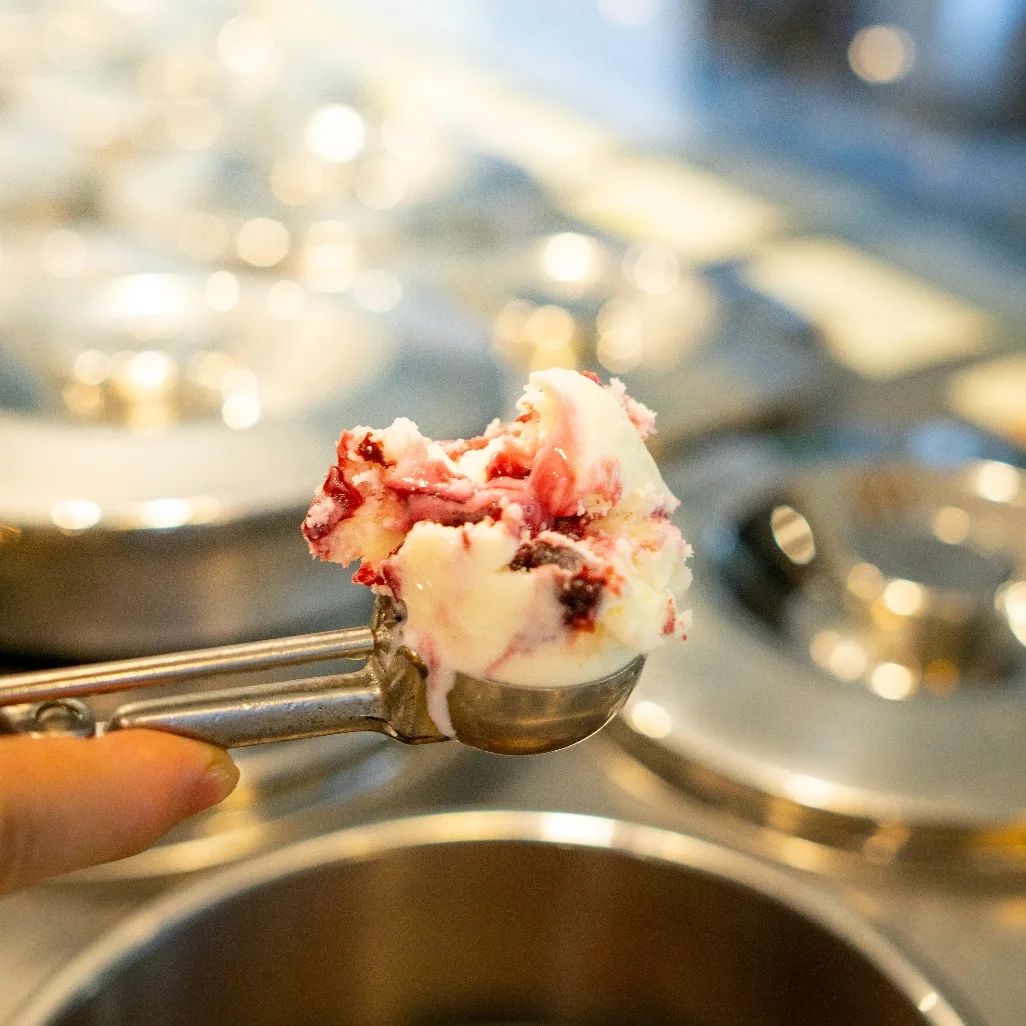The signs of good gelato–authentic, high-quality, naturally made gelato–are relatively well advertised in this day and age: there should be silver-lidded or low-filled containers rather than overflowing tubs, no artificial colors that look like they didn’t come from nature, and rotating seasonal flavors. A bonus is when certain flavors include textures that demonstrate the gelateria’s commitment to fresh ingredients, like a pistacchio that is chunky and thick with the actual chopped nuts, or a mint gelato with flecks of the freshly chopped herb strewn through.
But there’s another qualifier to look for. Savory gelato flavors–inspired by savory dishes and ingredients and/or flavors that lean more salty than sweet–have already been on the rise for several years in some of Rome’s top gelaterias. But now, not only are savory flavors becoming even more varied and ambitious in their essence, they are also acting as an almost accidental, additional sign of quality for the gelaterias that create them by showcasing the gelato maker’s culinary creativity, talent for complex recipe development, and focus on individual ingredients.
First, a bit of semantics between Italian and English: while the Italian translation of “savory” would typically be “salato,” Marco Radicioni of Otaleg gelateria in Rome says he and other Italians prefer to call these non-traditional, non-dessert-inspired flavors “gelati gastronomici” (“gastronomic gelato”) or “gelato gourmet,” because “salato” would imply literal saltiness, “which is not always the case,” Radicioni says. It’s true, flavors such as Gorgonzola with port (creamy and funky but sweet enough from the wine) and a chard and beet greens flavor sweetened slightly with raisins and orange zest do maintain a detectable amount of sugar and work well as palate cleansers after a meal similarly to, say, fior di latte gelato or a fruit sorbet.

A cone of chocolate cactus pear and licorice gelato from Otaleg
But then there are flavors like marinated fennel with white vinegar–a refreshing, tart, punchy gelato that Otaleg made in June that tastes definitively vegetal–that hit the tongue like a good salad with flaky Maldon salt on top. Technically, as Radicioni explains, salt actually has an anti-freezing effect, so it must be used extremely carefully in proportion to everything else in the recipe in order for the gelato to be successful not only gastronomically, but chemically. Nonetheless, flavors that lead with typically savory ingredients (or are inspired by savory dishes) give an impression of what we would call a savory flavor profile in English.
Several major Italian cities such as Milan, Bologna, Florence, and Turin are home to gelaterias that experiment with savory flavors; and in Liguria, Genovese basil is never a far reach for gelaterias to show off some local pride for the region’s favorite native ingredient. Plenty of flavors across these cities and regions make perfect sense and by now aren’t necessarily met with a great degree of shock: zucca (winter squash), a naturally sweet vegetable to begin with, isn’t hard to imagine as translating well into gelato, and olive oil gelato has been a popular, almost quintessential, choice for a savory base–even for gelato makers outside of Italy–in the last decade or so.
But beyond these flavors based on single (savory) ingredients, it is the more complex ones that reveal a level of creativity and cheffy-ness that sets a gelateria apart from its peers–like flavors inspired by typical savory pairings or by an entire dish from beyond the dessert world.
Recently, in Rome, such flavors might be simple duos and trios like butter and sage with hazelnuts in honor of autumnal pastas (at Fatamorgana, Maria Agnese’s gelateria that now has several locations throughout Rome’s center) or the evergreen cacio e pepe (at Torcè, founded by Claudio Torcè with locations in Rome’s Aventino, EUR, Parioli, and Marconi neighborhoods).
Katie Parla, the food writer and culinary expert who has lived in Rome for more than 20 years, remembers when Torcè started experimenting with savory flavors back in 2010: “[they] pushed the boundaries of what Romans were willing to accept as dessert.” Today, Torcè still regularly offers their longtime signature flavors like celery, habanero pepper, and Gorgonzola with pear—which, in their simplicity, might be the perfect gateway drug to the savory side of gelato for first-time tasters. (Those of you who haven’t yet noticed that you’ve been reading these sentences with furrowed brows and a scowl of distaste.)

Fennel gelato at Torcè, Courtesy of @gelateria_torcè
But before you start to think that you’d never want to taste savory notes when you’re craving a frozen treat, Marco Radicioni–founder of Otaleg, one of Rome’s now most beloved gelaterias–would remind you that people have been making savory (“gourmet”) flavors for a hundred years or more, it’s only that “seeing them regularly in the lineup of a gelateria is a more recent thing.” Parla similarly points out that savory gelato and sorbet have been showing up on fine dining restaurant menus for decades, as components in savory dishes “for flavor and texture contrasts” completely separate from dessert menus.
Even today, savory flavors offer the chance to experiment with pairings that would work just as well in a full meal context as they do in gelato form. Parla notes that cheese- and yogurt-based flavors are a logical, delicious choice with fruit sorbets. “The cheese flavors are definitely the most popular,” Radicioni notices among Otaleg’s customers. “But the fun thing is to enrich them with other ingredients that enhance their savory notes, rather than leaving them pure.”
If Torcè’s single-ingredient flavors are an entry point for the uninitiated savory eater, Otaleg is the mothership for the radicalized. Some of Radicioni’s seasonal experiments have included caper powder with white chocolate and even aglione–a flavor made from Tuscany’s giant-sized garlic from the Val di Chiana, with parsley and rosemary. In the early days of fall, a gelato inspired by pumpkin-pecorino soup and another called “spinach squared”–a spinach base, spinach leaves, and crispy guanciale–graced the menu.
These can be exciting prospects for the rare breed of individual who claims to be “not a dessert person,” or maybe it’s the hottest day of summer and the only form of food you can imagine consuming is gelato, but it’s lunchtime and you’re understandably ready for a savory meal. Otaleg’s summer flavors like the aforementioned fennel marinated in white wine vinegar, or panzanella–yes, that’s gelato based on the salad of bread, tomatoes, and basil–are your saviors.
By now, “our clients are used to reading something extravagant on the menu every day,” Radicioni says. Does it mean the savory flavors are more popular today than when they first started to appear? Radicioni notices that they might be more popular as flavors to take home when, for example, customers are hosting dinners in their homes–“through the years they’ve seen these flavors as a means to, perhaps, amaze their guests.”

Zabaione and rice, honey, and cinnamon flavors at Crema Alta Gelateria
Parla notes too that the Romans she knows “have a range of opinions on the matter. Some are creatures of habit that would never vary from the classics like pistacchio, zabaglione, crema… while others are more than willing to try something different out of curiosity.”
While savory gelato undoubtedly had a popularity spike in the early 2010s, according to Parla, “the fact that many places in Rome are still offering savory flavors since the trend started means they must be resonating with at least a portion of customers.”
Fortunately for that population, Radicioni remains undeterred in his exploration of new savory frontiers. While he likes to bring back favorite flavors from one past season to the next, Radicioni puts out brand new ones on a weekly and almost daily basis. The common thread is the way these flavors push the limits of what gelato can be in the popular imagination, thanks to the never-ending creative feedback loop in Radicioni’s head.
“When I make something it’s because I have to make it,” Radicioni professes. “Sometimes memories of mine emerge from a long time ago…of dishes that just explode on your tongue, and suddenly you absolutely have to try to turn those flavors into gelato.” Radicioni also credits the numerous chefs (from the culinary sector rather than pastry or gelato) who have worked at Otaleg over the years, who “give us inspiration as well as gaining inspiration from us” when developing new flavors.
All in all, any sort of popularity contest isn’t the utmost priority to Radicioni. “The important thing is to never close the door on creativity,” he stresses. Besides a commitment to the highest-quality ingredients sourced from trusted producers and treated with natural preparation methods, that might be the most selling point of all.







